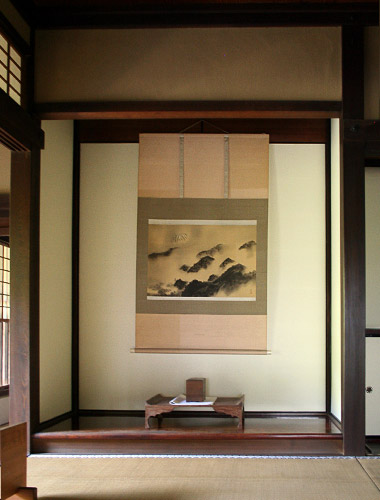|
||
 |
||

Nagatomi
永富 house (Hyougo)
(C)2001 Japanese Architecture and Art Net Users System. No reproduction or republication without written permission.
掲載のテキスト・写真・イラストなど、全てのコンテンツの無断複製・転載を禁じます。
|
||||||
| itadoko 板床 | ||||||
| KEY WORD : architecture / tea houses | ||||||
| An alcove with a wooden floor instead of a *tatami
畳 mat. There are two methods of making an itadoko. The first is to construct
a framing board like those in an ordinary alcove *tokonoma
床の間, and set the board floor even with the top of the frame which raises the alcove
floor above the tatami mat floor of the tea ceremony room *chashitsu 茶室. Red pine, zelkova
or Japanese horse chestnut are commonly used for the flooring. The frame can be
finished with black lacquer, plain wood with the grain visible, or a bark-covered
piece of wood cut from a log showing the marks of an adze *chouna
釿. Example: Saigyouan Kainyoan 西行庵皆如庵, in Kyoto. The other method is called *kekomidoko
蹴込床 and does not elevate the boarded floor of the alcove above the level of the
tatami mat floor of the tea ceremony room. Example: Fujimitei 富士見亭 at Gotou
五島 Museun, in Kyoto. |
||||||
 Nagatomi
永富 house (Hyougo)
|
||||||
| REFERENCES: | ||||||
| EXTERNAL LINKS: | ||||||
| NOTES: | ||||||
(C)2001 Japanese Architecture and Art Net Users System. No reproduction or republication without written permission. 掲載のテキスト・写真・イラストなど、全てのコンテンツの無断複製・転載を禁じます。 |
||||||